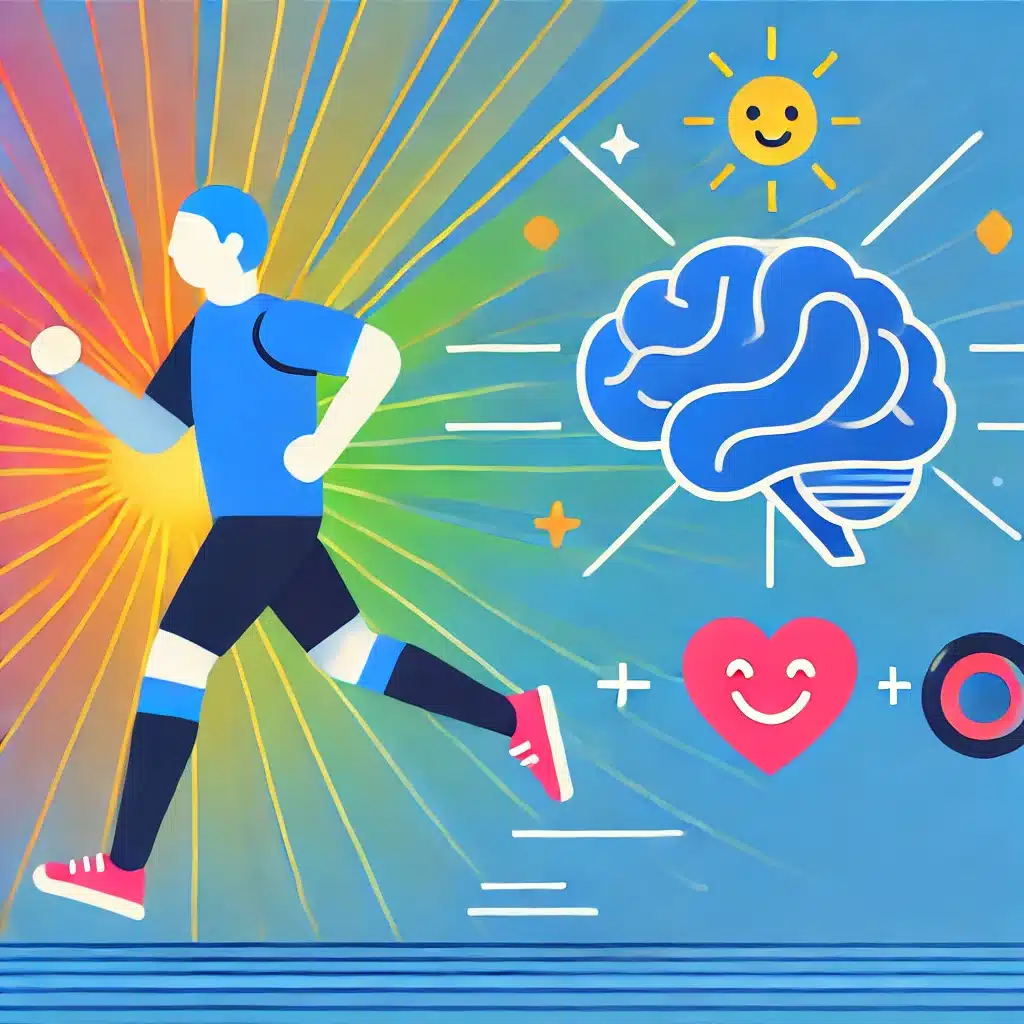Aerobic exercise reduces depressive symptoms by decreasing inflammation, boosting dopamine transmission, and enhancing motivation and cognitive control.
Highlights:
- Depression & Dopamine: Depression is linked to disrupted dopamine transmission, affecting reward processing and motivation, particularly in effort-based decision-making.
- Inflammation’s Role: Exercise reduces systemic inflammation, which otherwise impairs dopamine transmission and contributes to depressive symptoms like anhedonia and fatigue.
- Exercise Benefits: Aerobic exercise enhances dopamine transmission, leading to increased motivation to exert effort for rewards and improved cognitive control.
- Randomized Trials: Numerous randomized controlled trials show that exercise has significant antidepressant effects, comparable to medications and psychotherapy.
Source: Translational Psychiatry (2024)
Major Findings: Antidepressant Mechanisms of Exercise (2024)
1. Depression & Motivation
Depression is not just about feeling sad; it significantly affects motivation and the ability to find pleasure in activities (anhedonia).
This lack of motivation is linked to disruptions in dopamine, a key brain chemical that influences reward processing and decision-making.
2. Impact of Inflammation
Inflammation, the body’s response to stress or injury, plays a crucial role in depression.
Higher levels of inflammation are often seen in people with depression, which further disrupts dopamine transmission and makes it harder for them to feel motivated or find pleasure in activities.
3. Exercise as a Solution
Aerobic exercise (like running or cycling) has been found to reduce depressive symptoms effectively. It does this by decreasing inflammation in the body.
Lower inflammation helps restore normal dopamine function, which is essential for motivation and reward processing.
4. Dopamine & Effort
Dopamine is closely tied to our willingness to exert effort for rewards.
In people with depression, impaired dopamine function makes it harder to engage in activities that require effort, leading to increased fatigue and cognitive impairment.
Exercise boosts dopamine transmission, making it easier for depressed individuals to exert effort and feel motivated.
5. Cognitive Benefits
Depression often comes with cognitive impairments, like difficulty concentrating or making decisions.
Exercise helps improve these cognitive functions by enhancing brain circuits involved in effort-based decision-making and cognitive control.
This means that exercise can make it easier for people with depression to think clearly and make decisions.
6. Comprehensive Benefits of Exercise
Beyond reducing inflammation and boosting dopamine, exercise also increases brain-derived neurotrophic factor (BDNF), which supports brain health, increases gray matter volume, decreases oxidative stress, and improves self-esteem and self-efficacy.
All these factors contribute to its powerful antidepressant effects.
7. Personalized Exercise Interventions
The study suggests that understanding these mechanisms can lead to personalized exercise programs tailored to individual needs.
For instance, people with higher inflammation levels might benefit more from specific types of exercise.
Personalizing exercise routines can enhance their effectiveness and ensure long-term adherence.
8. Supporting Evidence
Meta-analyses (studies that combine results from multiple studies) show that individuals who engage in regular physical activity have significantly lower odds of developing depression.
Exercise interventions have been shown to be as effective, if not more, than traditional treatments like medications or psychotherapy.
9. Practical Applications
These findings underscore the potential of exercise as a scalable, low-cost intervention for depression.
Promoting exercise could not only help treat depression but also prevent it, addressing a major public health issue given the low levels of physical activity in the general population.
Study Details: Antidepressant Mechanisms of Aerobic Exercise (2024)

The study aimed to understand the mechanisms by which aerobic exercise exerts its antidepressant effects, focusing on the role of motivation, inflammation, and dopamine transmission in reducing depressive symptoms, particularly anhedonia, fatigue, and cognitive impairment.
Sample
The study drew on a broad range of research, including both human and animal studies, to formulate its hypothesis.
Specific sample details, such as the number of participants or their demographic characteristics, were not directly provided as the study primarily reviewed existing literature and proposed a new framework based on this evidence.
Methods
Literature Review: The study reviewed extensive research on the relationship between physical activity and depression, focusing on neural and cognitive processes like dopamine transmission, fronto-striatal brain activity, reward processing, and motivation.
Hypothesis Development: A novel hypothesis was proposed, suggesting that aerobic exercise reduces systemic inflammation, which in turn boosts dopamine transmission. This mechanism is believed to enhance effort-based decision-making, thereby improving motivation and reducing depressive symptoms.
Mechanistic Pathways: The study examined various pathways through which exercise might influence depressive symptoms, including:
- Reduction of systemic inflammation.
- Enhancement of dopamine transmission.
- Improvement of cognitive control through changes in brain circuitry.
Analysis of Previous Studies: Meta-analyses and randomized controlled trials (RCTs) were analyzed to assess the efficacy of aerobic exercise in treating depression. The study compared the effects of exercise with those of standard treatments like medication and psychotherapy.
Limitations
- Heterogeneity of Studies: The reviewed studies varied significantly in their methods, types of exercise interventions, and measures of depressive symptoms, making it challenging to draw definitive conclusions about the exact mechanisms of exercise’s antidepressant effects.
- Lack of Direct Evidence: Although the study proposed a comprehensive framework, direct evidence linking all the proposed mechanisms in a single study is limited. Most findings are based on separate studies examining different aspects of the hypothesis.
- Difficulty in Blinding: Exercise studies face challenges in blinding participants to the intervention, which might introduce placebo effects. However, comparisons between aerobic and non-aerobic exercises suggested that differences are not solely due to placebo.
- Variability in Inflammatory Response: The anti-inflammatory effects of exercise may differ based on individual factors such as sex, baseline inflammation levels, and specific types of exercise, making it difficult to generalize the findings.
- Need for Long-Term Studies: Many studies reviewed were of short duration. Long-term studies are needed to fully understand the sustained effects of exercise on depression and its underlying mechanisms.
Exercise for Antidepressant Effects (Recommendations)

To achieve antidepressant effects through aerobic exercise, it is essential to engage in regular physical activity.
While the exact amount and type of exercise can vary based on individual preferences and capabilities, the following guidelines and specific protocols have been shown to be effective:
General Guidelines:
- Frequency: Aim for at least 3-5 days per week.
- Duration: Each exercise session should last between 30 to 60 minutes.
- Intensity: Moderate to vigorous intensity is recommended. This means that the exercise should elevate your heart rate and make you breathe harder, but you should still be able to carry on a conversation.
Specific Protocols to Try
1. Walking or Jogging
Beginner Level:
- Frequency: 3-4 times per week
- Duration: 30 minutes per session
- Intensity: Start with brisk walking and gradually increase to jogging as fitness improves
Intermediate Level:
- Frequency: 4-5 times per week
- Duration: 45 minutes per session
- Intensity: Mix walking and jogging, aiming for a steady pace that slightly challenges your endurance
2. Cycling
Indoor Cycling:
- Frequency: 3 times per week
- Duration: 45 minutes per session
- Intensity: Participate in a structured spin class or use an indoor bike with varied resistance levels
Outdoor Cycling:
- Frequency: 3-4 times per week
- Duration: 45-60 minutes per session
- Intensity: Choose routes with varied terrain to challenge different muscle groups and cardiovascular endurance
3. Swimming
- Frequency: 3-4 times per week
- Duration: 30-45 minutes per session
- Intensity: Aim for continuous swimming with minimal breaks, using different strokes to engage various muscle groups
4. Group Fitness Classes
Examples: Aerobics, Zumba, or high-intensity interval training (HIIT)
- Frequency: 2-3 times per week
- Duration: 45-60 minutes per session
- Intensity: Participate in classes that challenge your cardiovascular system and provide a social aspect for additional mental health benefits
5. Running
Beginner Level:
- Frequency: 3 times per week
- Duration: 20-30 minutes per session
- Intensity: Start with a combination of walking and running, gradually increasing the running intervals
Intermediate to Advanced Level:
- Frequency: 4-5 times per week
- Duration: 30-60 minutes per session
- Intensity: Include a mix of steady-state runs, intervals, and tempo runs to enhance cardiovascular fitness and endurance
Tips for Success
Consistency: Regular exercise is key. Find activities you enjoy to make it easier to stick with your routine.
Progression: Gradually increase the intensity and duration of your workouts as your fitness improves.
Variety: Mix different types of aerobic activities to keep your routine interesting and engage various muscle groups.
Listen to Your Body: Pay attention to how you feel during and after exercise. It’s important to challenge yourself but also to avoid overexertion and injury.
Social Support: Exercising with friends or joining a group can enhance motivation and provide additional mental health benefits through social interaction.
Conclusion: Aerobic Exercise for Depression
References
- Study: From movement to motivation: a proposed framework to understand the antidepressant effect of exercise (2024)
- Authors: E J Hird







